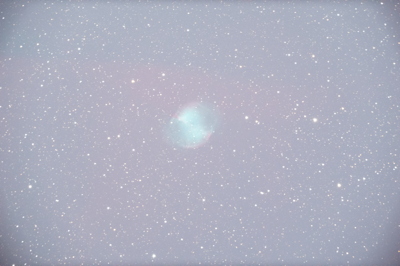Review - Explore Scientific 2" UHC Filter
Posted: 4 September 2020

2" UHC Filter
Explore Scientific
$130
I recently won an Explore Scientific 2" UHC Filter as a gift while watching the Explore Alliance OpenGOTO Community live video stream (which is currently online Monday through Friday at 4 PM Central Time). I highly recommend watching this show, as well as the weekly Explore Alliance Virtual Global Star Party. You will learn a lot about astronomy, astrophotography, telescopes, eyepieces, and more. And you could win cool stuff!
This is an ultra-high contrast narrow-band filter for observing a broad range of nebulae. It is spec-ed at 458nm to 508nm (O-III and H-Beta) with a peak at 488nm. Light transmission is 96.7%. As with all Explore Scientific accessories, it comes in a nicely designed, well-padded, box. It includes a small case for the filter and a Filter Test Sheet. The Test Sheet shows a secondary peak 670nm to 700nm.


Of course, when the filter arrived the sky was cloudy for an extended period of time due to our Monsoon weather pattern. Once the weather improved I was able to do some tests with the filter. As I live in a rural area with a dark sky (our local State Park is an IDA "International Dark Sky Park") I did not expect to see much improvement when viewing Deep Sky Objects (DSOs) with the filter. However, there is some light pollution from Tucson, Oro Valley, and Catalina low in my southern sky so objects there made for good test objects.
To simplify testing with and without the filter I used the Starizona Filter Slider System on my 12" f/8 telescope.

Visual Tests
When the night sky finally cleared there was a Full Moon. The sky brightness mimicked how the sky would look in a severely light polluted area. I compared the view of M8 (Lagoon Nebula) and M17 (Swan Nebula), 102X, without and with the filter. Both were difficult objects to see without the filter against the bright sky, but were easily seen with the filter, demonstrating the effectiveness of the UHC Filter. I also viewed Jupiter, 102X, through the filter. Jupiter had a green tint, so expect that bright objects viewed through the filter will have a slight green tint.
The next night I added a M42-SCT adapter to my Starizona Filter Slider System to allow me to use an eyepiece with the holder. The adapter let me attach a SCT visual back onto the holder, seen here using a 1.25" 26mm eyepiece (yielding 94X), with and without the filter tray in place.


I viewed several Deep Sky Objects with and without the filter. Using the Filter Slider System made it very easy to compare the views with and without the filter by sliding the filter tray in and out.
The sky was less illuminated by the near Full Moon but there was still some brightness from the twilight sky. The sky brightness did a nice job simulating light pollution.
I compared the views of M8 (Lagoon Nebula), M17 (Swan Nebula), M20 (Trifid Nebula), and M57 (Ring Nebula) without and with the filter. The visibility of all these nebulae were improved by using the UHC Filter, sometimes with significant improvement. I also viewed M22 (globular cluster) without and with the filter. The stars of the cluster were fainter (not surprising) with the filter and had a slight green tint. Otherwise, there was no change in the visibility of the globular cluster.
Basically, depending on the object being viewed and the sky conditions, the improvement in the visibility of the object and the details seen will vary from dramatic to none. Keep in mind that using the filter visually will dim much of the light from most objects, allowing only the specific wavelengths to be seen.
Astrophotography Tests
I mounted a D850 DSLR at prime focus of the 12" f/8 telescope using the Starizona Filter Slider System to do imaging tests of some nebulae without and with the filter. The rising waning gibbous Moon created some sky brightness. All of the following images were StarLock autoguided, 3 minute exposures, ISO 6400, White Balance 5560K.
M8 Lagoon Nebula (L - unedited, no filter, R - unedited, UHC Filter)


M8 Lagoon Nebula (L - edited, no filter, R - edited, UHC Filter)


M17 Swan Nebula (L - unedited, no filter, R - unedited, UHC Filter)


M17 Swan Nebula (L - edited, no filter, R - edited, UHC Filter)


M20 Trifid Nebula (L - unedited, no filter, R - unedited, UHC Filter)


M20 Trifid Nebula (L - edited, no filter, R - edited, UHC Filter)


M57 Ring Nebula (L - unedited, no filter, R - unedited, UHC Filter)


M57 Ring Nebula (L - edited, no filter, R - edited, UHC Filter)


M27 Dumbbell Nebula (L - unedited, no filter, R - unedited, UHC Filter)


M27 Dumbbell Nebula (L - edited, no filter, R - edited, UHC Filter)


Summary
For bright nebulae with a moonlit (or light polluted) sky, the Explore Scientific 2" UHC Filter can be effective to bring out some aspects of the object both visually and photographically, depending on the object itself and the sky conditions. I have had a different UHC filter for many years, but never really used it much visually and never for astrophotography with my dark sky. With the convenience of the Starizona Filter Slider System and the results of these tests I will be doing more observing and astrophotography using the Explore Scientific 2" UHC Filter. No matter what your sky conditions, using the Explore Scientific 2" UHC Filter will enhance your experiences.
Comments are welcome using Email. If you are on Twitter you can use the button below to tweet this review to your followers. Thanks.
Cassiopeia Observatory Home Page
Copyright ©2020 Michael L. Weasner / mweasner@me.com
URL = http://www.weasner.com/co/Reviews/2020/ES_UHC_Filter/index.html

